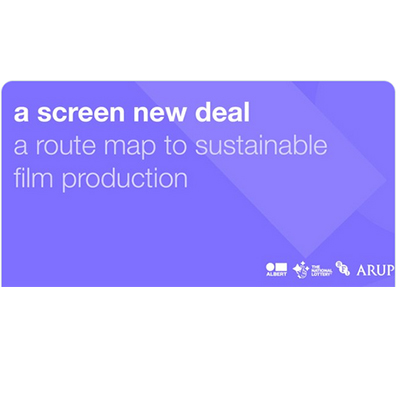BFI, Albert and Arup launch ‘a screen new deal – a route map to sustainable film production’

Date Posted: September 3, 2020
- ‘First of its kind’ report proposes a step-change in the way the industry operates and sets out a route map to help film production transition to net zero emissions by 2050 in line with Government legislation
- Carbon footprint of film production analysed to identify key areas where improvements need to be made to reduce carbon emissions in film production
- Innovations illustrated across five key areas: production materials, energy and water use, studio buildings and facilities, studio sites and locations and production planning
- Practical guidance and case studies offer insights on how film production can work to meet a net zero target
- Data analysed shows that the average tentpole film generates 2,840 tonnes of CO2e, the equivalent of 11 one-way trips from the Earth to the moon
A new report published today, A Screen New Deal – a Route Map to Sustainable Film Production, examines the systemic changes needed within film production in order to reduce its carbon emissions as well opportunities and models that can be adopted to put it on a trajectory to reach net zero carbon emissions and a more sustainable future.
The report looks at everyday practices and offers a range of long-term solutions, some that are relatively simple to implement, to bigger, more ambitious ideas which require structural industry-wide shifts to implement successfully. Case studies from other industries that could be adapted to work for the film production industry are also explored.
It concludes with six principles on which a sustainable future depends, starting with the need to measure the industry’s true environmental impact. Digital collaboration and end-of-life planning will also be fundamental, along with the right infrastructure at studio sites to support sustainable production. Actionable recommendations are provided for each stakeholder in order to facilitate prioritisation and decision-making.
To produce the report, Arup analysed sustainability data from more than 19 productions filmed in the UK and the US in the last five years to assess resource consumption patterns and carbon emissions. Tentpole films (with budgets at $70m or over) were chosen for the analysis on the basis that they would have the largest carbon footprint although guidance and resources detailed in the study are of value to films at all budget levels.
Publication of the report is timely in regard to the UK’s commitment to net zero emissions by 2050. Last month the Committee on Climate Change (CCC) published its report stating that the year ahead is critical for global progress on climate change. It also provided “new advice to Government on framing a recovery from Covid-19 that both accelerates the transition to net zero and strengthens our resilience to the impacts of climate change, whilst driving new economic activity on progress in reducing UK emissions over the past year.” Next year the eyes of the world will be on the UK, as the host of the rescheduled 26th ‘Conference of the Parties’ climate summit (COP26) and in holding the presidency of the G7.
The UK film production sector has seen enormous growth with over £3.6 billion spent on making new film and high-end TV productions in the UK last year. With the first quarter of this year heading towards a £1 billion spend in the UK, many productions halted in the wake of COVID-19 pandemic but are now moving to a restart with new production health and safety guidance in place. The projected growth of the film industry globally emphasises the urgency of a shift towards more sustainable practices.
On average a tentpole film generates 2,840 tonnes of CO2e during production. This total carbon impact is equal in air miles terms to 11 one-way trips from the Earth to the moon; emissions contributed by air travel alone on a production is equivalent to flying one way from London to New York 150 times, or 3.4 million car miles. The carbon footprint from accommodation used on a production is equivalent to the use of electricity by 34 homes for one year.
The UK has seen expansion in studio space over the past five years with a number of new facilities currently in development. The new streaming platforms are increasing demand for content and high-quality studio space is rising as demonstrated by Netflix setting up a permanent production base at Shepperton and Disney at Pinewood.
Harriet Finney, Director of External Affairs for the BFI, says: “Our film and screen production industries are facing an undeniable period of change as we enter a world which is responding creatively and economically to harsh impacts of the pandemic. Commissioned last year, the purpose of this report by Arup was to share innovation and knowledge and help kick-start a more sustainable production ecosystem. Arriving now – just as productions restart and introduce new ways of working on set and on location – there is an opportunity to consider how we create efficiencies in our approach to materials and resources and learn how innovation is working for other industries. This piece of work is not the solution to delivering greater environmental sustainability but it provides us a valuable route map for taking forward positive action.”
Pippa Harris, Chair of the albert Film Forum and Producer at Neal Street Productions, says: “This report is being published at such an important moment for our industry. We have all felt the devastating economic and cultural effects of the pandemic, so now is the time to regroup and come back stronger. We cannot continue to create films in the same manner we did before with no long-term plan for the environment around us. It’s time for our industry to lead the way both on and off screen and rebuild for a cleaner, greener future.”
Aaron Matthews, Head of Industry Sustainability, albert, says: “We want this report to kick-start a long overdue conversation with the key decision makers in the film industry. As we emerge from lockdown we need to rethink our approach to filmmaking, if we simply pick up where we left off we will miss our chance to deliver what is environmentally necessary. The changes suggested in this report can’t be implemented overnight and some of them require a new way of thinking but grasping this challenge now will lead to improved efficiencies in the way we work, meaning more cash can be spent on what we see on screen rather than what we have to currently send to landfill.”
Tim Snelson, Associate Director, Arup, says: “Renewable options becoming increasingly available and cheaper. Our study highlights the complexity, urgency and importance of more sustainable and resource-efficient approaches to film production. This complexity is an opportunity, a chance to look at radical new ideas and to learn from innovation in other industries. Solving the sustainability challenge will be a competitive advantage that the UK production industry should pursue collectively and with a clear vision.”
Following the publication of the report, albert will be hosting a series of online events with the support of BFI and Arup to explore the different sections of report. The event programme will kick off with an online webinar on September, hosted by Pippa Harris that will look at the report as a whole.
A Screen New Deal – a Route Map to Sustainable Film Production is the second stage in research published by the BFI in partnership with albert and can be read here. Green matters – Environmental sustainability and film production, an overview of current practice which drew together evidence and first-hand experience from industry practitioners, was published in February and can be read here.
Events focusing on specific areas of production explored in A Screen New Deal such as production planning, set construction and strike, location filming, will be hosted by BAFTA albert, the BFI and Arup, in the coming weeks for the industry to discuss the practices and models that could adopt to meet net zero emissions by 2050 – register here.
REPORT HIGHLIGHTS
Production and carbon emissions
Arup’s research shows that transport has the largest impact in terms of carbon emissions accounting for approximately 51% of total emissions for tentpole films. Of this 30% is associated with air travel and 70% with land transport. Mains electricity and gas use is the second largest contributor accounting for almost 34% of total emissions and the remaining 15% is from the use of diesel generators. There are renewable alternatives that could help the transition towards more sustainability.
Taking a holistic look across the industry, this research looks at five key areas of opportunity for transformation and three corresponding interventions:
- production materials – reusing materials, buying virgin materials responsibility and resource-efficient set construction;
- energy and water use – energy demand reduction, sustainable energy sources and water demand reduction;
- studio buildings and facilities – repurposing buildings, buying products as a service; and smart building management;
- studio sites and locations – consolidated movement, wayfinding and communication and health and wellbeing services; and
- production planning – collaboration tools, virtual planning and shared infrastructure.
Production materials
A large proportion of materials are bought or made to specification and regardless of their low recyclability, synthetic foam and adhesives are popular whilst digital fabrication which could achieve similar results with less waste is not commonly used because it can sound expensive. Production studios are not involved in the procurement or disposal of materials.
Materials left at the end of productions are recycled where possible with some reuse but the remainder to sent to processing for energy regeneration from waste or landfill. Key factors limiting material reuse include short strike times; a lack of shared information on available materials; high storage costs; and the limited numbers of reuse service providers.
Online sharing platforms can allow separate productions to exchange materials with each other extending material use. Warehouses with logistics and quality control functions could reduce transportation and reuse network costs. Material passports aid ‘reuse’ networks providing information about source, specification and location as well as operational requirements. Material passports can be linked to production schedules to create stock inventories and help planning.
Energy and water
Few studios operate on renewable energy tariffs or generate renewable energy on site. Energy demand can be reduced also through green design solutions such as daylighting, natural ventilation, solar shading and solar gain, low energy lighting and using systems for heat recovery ventilation. The installation of micro renewable technologies mounted on roofs or building facades and wind turbines can help towards a zero-carbon economy. Trailers with solar roof installations, biodiesel or battery-powered generators, which can replace diesel generators in a number of situations, can help on location. Microgrids can match energy supply and demand reliably and are well-suited to production energy consumption patterns.
Water from the mains supply can be reduced by installing rainwater harvesting and greywater recycling. Waterless toilet solutions could minimise the water demand associated with chemical toilets. Mains electricity and water connections could replace diesel generators and water bowsers.
Studio buildings and facilities
Changing requirements from production to production mean that studio spaces are sometimes under-utilised, however industry requirements may compel studios to implement flexible and adaptable design for new and retrofitted buildings. Flexible spaces can increase rentability and with the film industry evolving, buildings need to remain fully functional by adopting adaptable design principles. Sensors embedded into building components and systems along with smart meters can provide insights into energy use and occupation to help optimise capacity.
The film industry is accustomed to renting costumes, props, generators and vehicles. This practice could be extended to temporary and permanent building components through product-as-a-service contracts with construction suppliers, whereby the supplier retains ownership and responsibility for maintenance. These contracts are available for lighting systems, air conditioning units, office fit-out, etc. Suppliers are incentivised to use real-time remote monitoring, keeping costs and downtime to a minimum. Modular construction off-site potentially, through a product as a service model, would help studios meet changing occupant requirements.
Studio sites and locations
The transport of people and goods to and from studio sites and locations is not coordinated efficiently. Signage at studios provides essential wayfinding information but there is no universal film industry signage for waste management. Physical wayfinding graphics are simple and can signal consistent waste and recycling points or health and safety requirements. Production is time constrained which often leads to incorrect waste disposal but a unified language across studios can further facilitate the adoption of these practices. Few amenities and spaces for rest or recreation are available at studios and as a result people are inclined to make additional trips to and from studio sites for their personal needs.
The increasing availability of transport data from smartphones and satellite tracking can help predict transport demand, reducing vehicle movements and in turn reducing pollution and costs. Carpooling apps provide flexible solutions and transport distances can be reduced by integrating a production hub within or near to the studio site or location. Centralised catering facilities could reduce single use crockery and cutlery; permanent kitchen spaces would use lower carbon cooking fuel than mobile facilities. Work-life facilities would allow workers to be healthy and productive and enhance their experience at work, eg childcare services, lockers for online shopping, changing rooms for workers wanting run or cycle.
Production planning
Digital tools can enable better planning and scene design. Communication platforms can integrate scheduling tools for agile coordination and will reduce paper waste but they rely on cloud infrastructure and data-sharing protocols to function requiring studios to provide sufficient network coverage. The data required by carbon reporting tools could be collected also by collaboration platforms for wider sharing and understanding sustainability challenges facing the industry.
The UK has a number of digital previsualisation (pre-vis) studios allowing directors and producers to test concepts, storyboards, sets and scenes before shooting. This results in fewer unnecessary set builds, requires less contingency planning, and reduces time, material use and costs. Virtual reality can allow directors to collaborate remotely in virtual scenes. 5G connectivity allows more rapid footage transfers after shooting, compressing work timelines, and 3D capture of existing props can become asset banks, helping set designers extend usage.
Technological advances in VFX, CGI and remote collaboration services are shifting larger proportions of production to virtual environments and these have the potential to reduce carbon emissions and waste but also have implications for the overall energy demand. Energy and workflow tools can influence efficiency, cost and energy consumption.
Regional online location libraries providing sustainability information, building ratings and performance can help location manager make more informed decisions. Studios could provide shared procurement services to consolidate orders and deliveries from local and global suppliers making sourcing quicker; a digitised database including sustainability credentials for suppliers would facilitate more informed procurement decisions to be made.



